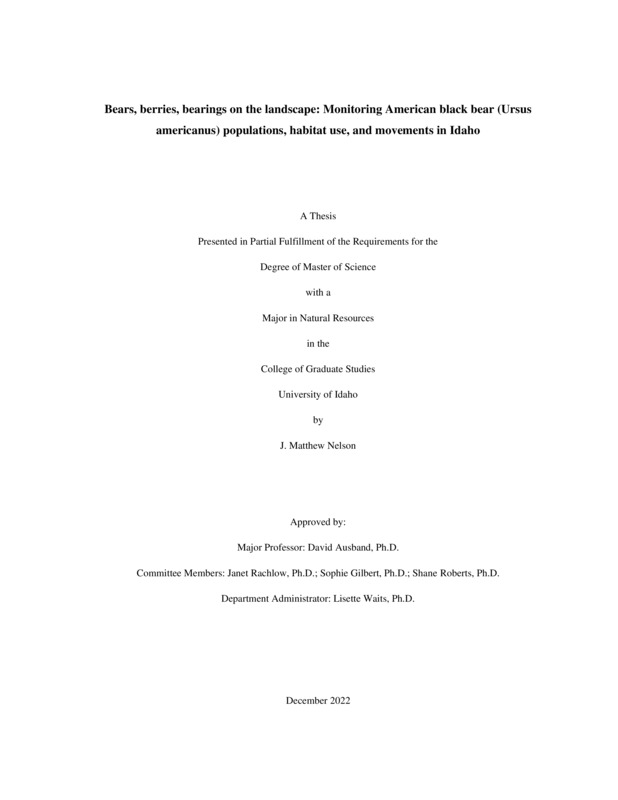Bears, berries, bearings on the landscape: Monitoring American black bear (Ursus americanus) populations, habitat use, and movements in Idaho
Nelson, J. Matthew. (2022-12). Bears, berries, bearings on the landscape: Monitoring American black bear (Ursus americanus) populations, habitat use, and movements in Idaho. Theses and Dissertations Collection, University of Idaho Library Digital Collections. https://www.lib.uidaho.edu/digital/etd/items/nelson_idaho_0089n_12386.html
- Title:
- Bears, berries, bearings on the landscape: Monitoring American black bear (Ursus americanus) populations, habitat use, and movements in Idaho
- Author:
- Nelson, J. Matthew
- ORCID:
- 0000-0001-8133-7366
- Date:
- 2022-12
- Keywords:
- black bear huckleberry population estimation recruitment remote cameras
- Program:
- Fish & Wildlife Sciences
- Subject Category:
- Wildlife management
- Abstract:
-
Black bears populations have historically been managed using harvest data and mark-recapture methods. New methods such as the time to event and space to event models have opted to estimate unmarked populations using trail cameras and have so far been tested on high density ungulate species and low density carnivore species. In the first chapter, we apply these two models to estimating black bear populations in several study areas across Idaho. Black bears represent an optimal species to test these models because they occur at a medium density between most carnivores and ungulates and have different movement patterns and life histories. We tested the efficacy of these models by comparing the resulting densities to comparable black bear densities found throughout similar habitats. We found that while the models did sometimes find comparable density estimates, they were often dependent upon camera placement style and the time to event model tended to overestimate populations frequently. Incorporating bootstrapping worked to bring some estimates into the comparable density range (particularly with time to event), but still resulted in high estimates. Bootstrapping the space to event model, however, often biased estimates quite low, presenting an issue where bootstrapping the models was not always the best course of action. Black bear recruitment in Idaho is strongly correlated with the late summer huckleberry crop, with low crops affecting fall black bear weights and the capability to successfully reproduce. In chapter two, we attempted to create a model predicting the huckleberry crop for the upcoming year so that managers could have a preemptive tool for managing black bear populations. Models for 2020 and 2021 found that there was some overlap in predictive covariates for huckleberry productivity, but several additional covariates were included in 2021. We also did not find a strong correlation between our 2020 model and black bear recruitment for the following year, possibly due to the short duration of our study.
- Description:
- masters, M.S., Fish & Wildlife Sciences -- University of Idaho - College of Graduate Studies, 2022-12
- Major Professor:
- Ausband, David
- Committee:
- Rachlow, Janet; Roberts, Shane; Gilbert, Sophie; Waits, Lisette
- Defense Date:
- 2022-12
- Identifier:
- Nelson_idaho_0089N_12386
- Type:
- Text
- Format Original:
- Format:
- application/pdf
- Rights:
- In Copyright - Educational Use Permitted. For more information, please contact University of Idaho Library Special Collections and Archives Department at libspec@uidaho.edu.
- Standardized Rights:
- http://rightsstatements.org/vocab/InC-EDU/1.0/

